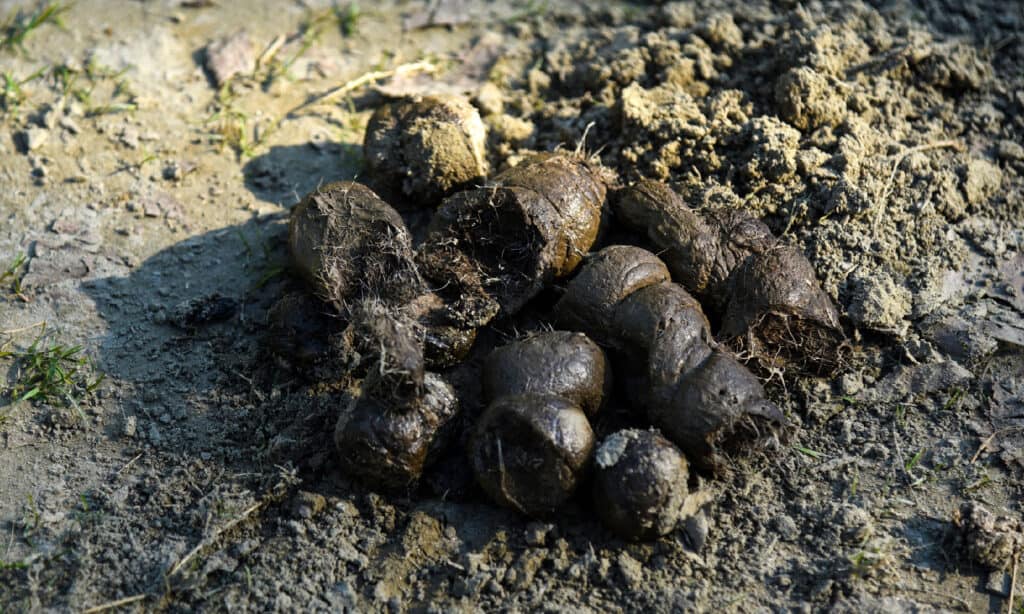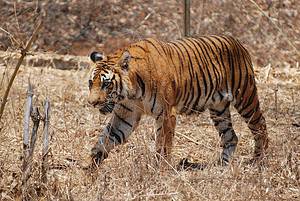With the scientific name Panthera tigris, tigers are the biggest members of the big cat family; significantly larger than a lion. These big cats are solitary carnivores that inhabit both warm and cold areas of Asia and are among the world’s most ferocious apex predators. There are nine known subspecies of tigers in the world. However, species like the Bali, Javan, and Caspian tigers are now extinct.
As mentioned earlier, these animals are significantly larger than lions. The largest tiger ever weighed more than 800 pounds while the largest subspecies of tiger is the Siberian, which has an average weight of 675 pounds. Even their tails can grow as long as three feet. It is intriguing to consider what tigers eat to retain their enormous size and whether or not they poop. This article will tell you everything there is to know about a tiger’s diet, what their poop looks like, and other interesting information.
What Do Tigers Eat?

Tigers are carnivores and some of the biggest apex predators in the entire world. These animals are not social and prefer to hunt for prey alone. However, on rare occasions, a group of tigers, called an ambush, could be found hunting together. Although all species of tigers are meat eaters, their preferred habitats determine their ideal choice of prey.
Essentially, tigers are carnivores and have the ability to capture and eat large mammals. Tigers use their stalking skills, speed, and quick movements to take down their prey. However, these big cats usually eat just once per week. The reason for this is that these big cats can eat up to 75 pounds of food in one sitting, and that fills them for the week.
Tigers also have a practice of killing prey, devouring as much of it as they want, and then covering the remainder with leaves so they can return for a snack later. Some of the prey that tigers consume include deer, antelope, buffalo, and wild boar. In addition, they devour leopards, sloth bears, and monkeys. Even crocodiles have been known to be eaten by tigers.
What Does Tiger Poop Look Like?

Tiger poop is usually a dark brown or grayish color and shaped like a segmented cube.
©iStock.com/D. Talukdar
Tiger poop looks like that of a domestic cat, but because of its massive size, they are at least a hundred times bigger. According to researchers, their poop is the size of an average beetroot. Although they are as big as a beetroot, they do not have the same color as a beetroot; tiger poop is usually a dark brown or grayish color and shaped like a segmented cube. It is primarily composed of solid matter, though there may be some white residue mixed in. The whitish residue contains calcium and serves as a sign of the animal’s well-being.
Also, depending on the last meal of a tiger, it is not uncommon to find a lot of fur or bones in its poop. Like other feces, including human excrement, tiger poop is encased in a layer of cells from the intestinal wall. Fresh tiger feces are normally accompanied by urine sprays. Most people that have come in contact with tiger urine at some point say that their urine has a surprisingly pleasant smell. The reason for the pleasant smell is that tiger urine contains pheromones that attract mates.
Do Tigers Bury Their Poop Like Other Domestic Cats?

Tigers like to bury their poop to mask their scents from other tigers or even predators.
©iStock.com/gracethang
Cats are known to bury their poop, so the question is, “do tigers do the same?” In the wild, one way animals track other animals is by their scent. Because of the pheromones present in a tiger’s urine which accompany their poop, it is easy for other tigers and animals to track a tiger down through their poop. For this reason, when they are within their home range, tigers like to bury their poop to mask their scents from other tigers or even predators.
To prevent possible predators from perceiving their cubs’ smells, tigresses may eat their feces. However, they do not bother to hide their poop when they are out of their territory. The reason they leave their feces out in the open there is because they are not very concerned about hiding their presence or they are trying to mark new territory.
Is Tiger Poop Harmful?
Humans can be exposed to pathogens from poorly managed animal feces. Environmental intestinal dysfunction, trachoma, soil-transmitted helminth infection, and diarrhea have all been linked to exposure to animal waste. Exposure to tiger poop is no different. Due to the fact that tigers eat other animals, their waste undoubtedly contains bacteria that might be harmful to people. It is advisable for people who handle tiger poop to not touch it with their hands but instead wear disposable gloves.
Is Tiger Poop Important?
Of all the nine tiger species to ever exist, there are still six left including the Sumatran, Siberian, Bengal, South China, Malayan, and Indochinese tigers. Examining the poop of tigers is helpful in identifying and locating all the different species of tigers. Also, tigers use the smell of their poop to find each other and their territories. For tigers in shelters or zoos, poop is one of the major ways that their keepers use to monitor their health and meet their dietary needs.
Up Next:
Liger vs Tiger: What are the Differences?
What Makes a Tiger’s Tongue Unique
Tiger Lifespan: How Long Do Tigers Live?
Hedgehog Poop: Everything You’ve Ever Wanted To Know
The photo featured at the top of this post is © iStock.com/Ondrej Prosicky
Sources
- Smithsonian's National Zoo & Conservation Biology Institute, Available here: https://nationalzoo.si.edu/animals/news/how-big-are-tigers-and-more-tiger-facts
- Nbc News, Available here: https://www.nbcnews.com/id/wbna40344642
- Eyebulb, Available here: https://eyebulb.com/what-does-tiger-poop-look-like/
Thank you for reading! Have some feedback for us? Contact the AZ Animals editorial team.






